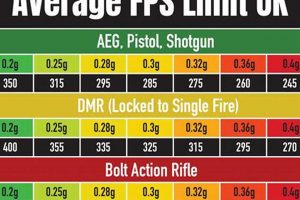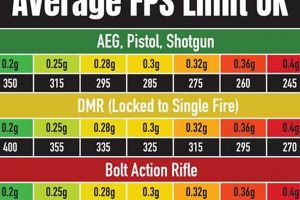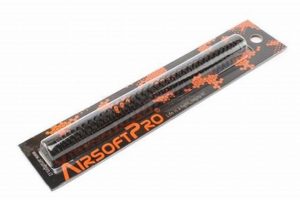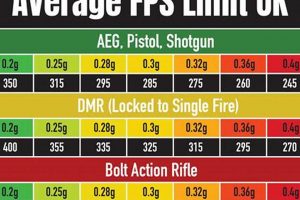A reference table correlating airsoft gun spring power with the resulting muzzle velocity, measured in feet per second (fps), provides valuable data for players and technicians. For instance, a specific spring designation, like an M100, might typically produce a velocity within the range of 320-350 fps, depending on factors such as barrel length, internal air seal, and BB weight. This correlation assists in selecting the appropriate spring to achieve desired performance characteristics.
The utility of these reference tools lies in ensuring gameplay legality and optimizing gun performance. Fields often impose velocity limits for safety reasons, and adhering to these regulations is paramount. Furthermore, understanding the relationship between spring power and muzzle velocity enables players to fine-tune their equipment for optimal range, accuracy, and consistency. Historically, these correlations have evolved alongside airsoft technology, becoming more precise and encompassing a wider array of spring types and configurations.
The information provided by these tools assists in the informed selection of components. This data enables modifications to meet specific field regulations, enhancing play experience through improved weapon accuracy and consistency. Following sections will cover methodologies for utilizing these correlation tools, the various types available, and critical considerations for accurate interpretation and application.
Guidance on Airsoft Velocity Tuning
The subsequent points offer guidance regarding the selection of internal components to achieve specific muzzle velocities in airsoft replicas, emphasizing consistency and adherence to safety protocols.
Tip 1: Select Spring Rating Based on Desired Velocity. Consult available tables to choose a spring rated to deliver the target muzzle velocity. Account for potential variations introduced by hop-up units and barrel length.
Tip 2: Chronograph Airsoft Replica Regularly. Velocity readings should be obtained routinely to ensure ongoing compliance with field limits and to detect any performance degradation.
Tip 3: Implement Air Seal Checks. A compromised air seal within the cylinder assembly diminishes power output. Conduct maintenance and replace components to ensure optimal compression.
Tip 4: Consider BB Weight Selection. Heavier projectiles necessitate more force for propulsion. Adjust spring tension, or utilize a spring with greater power, to compensate for increased weight.
Tip 5: Monitor Temperature Effects. Environmental conditions can impact gas pressure and component elasticity, potentially altering velocity. Adjust accordingly during periods of temperature fluctuation.
Tip 6: Account for Hop-Up Influence. Over-adjustment of the hop-up unit can reduce velocity. Optimize the unit’s setting to balance range with minimum velocity reduction.
Tip 7: Validate Spring Compatibility. Not all springs are interchangeable; ensure compatibility with the airsoft replica’s gearbox and piston assembly to prevent mechanical failure.
The proper application of these considerations supports accurate velocity adjustment within airsoft replicas, maintaining safe operational parameters.
Proceeding sections will address prevalent errors associated with velocity modifications, and methods for their remediation.
1. Spring Designation
Spring designation serves as a primary indicator within velocity correlation tools, establishing a performance baseline. Each designation, typically represented by an “M” number (e.g., M100, M120), denotes the approximate spring force, which directly influences the potential energy imparted to the projectile. This designation allows for predicting the velocity range that a specific spring will produce under standard conditions. A higher “M” number corresponds to a greater spring force and consequently, a potentially higher muzzle velocity. Understanding this correlation enables players to select springs that align with field regulations and desired performance characteristics.
The “M” designation’s practical significance becomes evident when considering field velocity limits. For instance, if a field mandates a maximum velocity of 400 fps with 0.20g BBs, a player can consult a correlation tool to identify an appropriate spring. An M120 spring, theoretically capable of exceeding this limit, might be deemed unsuitable. Conversely, an M100 spring, projected to produce a velocity within the acceptable range, becomes the more appropriate choice. This proactive approach prevents non-compliance and ensures safe gameplay. In this scenario, spring designation serves as a pivotal parameter, ensuring compliance with standardized performance thresholds.
Accurate interpretation of the “M” designation, in conjunction with comprehensive correlation tools, facilitates informed component selection and promotes adherence to safety standards. However, several factors, including variations in manufacturing tolerances and internal component efficiency, can influence the achieved velocity. Therefore, while the “M” designation provides a crucial starting point, consistent chronographing and meticulous equipment maintenance remain essential for maintaining optimal performance and ensuring gameplay legality. Future analysis will explore the impact of barrel length and internal air seal on the final velocity output, further refining the understanding of performance tuning.
2. Muzzle Velocity
Muzzle velocity represents a critical parameter in airsoft, defining the speed at which a projectile exits the barrel of a replica. Its precise measurement and regulation are fundamentally linked to the utility of velocity correlation tools, as it dictates adherence to safety protocols and field-specific limitations.
- Velocity Regulation Compliance
Field regulations often stipulate maximum muzzle velocity limits to ensure player safety and prevent excessive force. This adherence requires a comprehensive understanding of how varying spring strengths influence projectile speed, using correlation tools as a guide. For instance, exceeding a 400 fps limit necessitates spring adjustment or selection of a lower-rated spring to maintain compliance and prevent disqualification from gameplay.
- Kinetic Energy Considerations
Muzzle velocity is directly proportional to the kinetic energy imparted on a projectile. Higher velocities translate to increased impact force, potentially leading to injury. Correlation tools assist in modulating velocity to maintain safe energy levels, especially critical when utilizing heavier projectiles that inherently increase kinetic energy even at similar velocities. This modulation ensures adherence to joule limits imposed by certain fields and organizations.
- Range and Accuracy Optimization
While adherence to velocity limits is paramount, optimizing velocity within these constraints is crucial for achieving desired range and accuracy. Correlation tools enable players to fine-tune spring selection to attain the maximum allowable velocity, maximizing projectile range and minimizing drop-off. This optimization requires careful consideration of projectile weight and hop-up settings to achieve a balanced performance profile.
- Chronograph Verification
Muzzle velocity correlation tools provide a theoretical framework, but consistent verification via chronograph testing remains essential. Chronographs measure the actual velocity of projectiles, allowing for comparison against predicted values and identification of discrepancies caused by variations in component efficiency or environmental conditions. This verification ensures that theoretical calculations align with real-world performance, safeguarding compliance and optimizing performance.
The correlation between expected muzzle velocity and measured performance, facilitated by these reference tools, supports safe and consistent airsoft gameplay. Adherence to regulations, optimization of kinetic energy, and maintenance of accuracy through informed spring selection remain central to responsible airsoft participation.
3. BB Weight Variance
Projectile weight directly influences the velocity achieved with a given spring force, a relationship clearly illustrated within velocity correlation tables. Increased mass necessitates greater energy to achieve the same velocity as a lighter projectile. Therefore, a specific spring propelling a heavier BB will result in a lower muzzle velocity compared to an identical spring firing a lighter BB. This principle is fundamental to understanding and utilizing these correlation tools effectively. For instance, a spring capable of producing 350 fps with a 0.20g BB might only generate 300 fps when used with a 0.28g BB, highlighting the significant impact of projectile weight. This variability necessitates careful consideration when selecting BB weight to remain within field-mandated velocity limits.
The practical implication of weight variance extends to gameplay tactics. Players seeking to maximize range may opt for heavier BBs, which exhibit greater stability in flight and resist wind drift more effectively. However, this choice necessitates a corresponding adjustment in spring strength to maintain acceptable velocity levels. Conversely, players prioritizing rate of fire might choose lighter BBs, but must ensure that the resulting velocity does not exceed safety regulations. Moreover, consistency in BB weight is paramount for maintaining accuracy and predictable trajectory; variations within a batch of BBs can lead to erratic shots and reduced effectiveness.
In summary, projectile weight is a critical factor influencing muzzle velocity. Accurate utilization of velocity correlation tools requires a thorough understanding of this relationship. While the tool provides a valuable reference, real-world results are contingent upon precise BB weight measurement and consistency. Disregarding weight variance can lead to non-compliance with field regulations or suboptimal performance. Proper BB weight selection, informed by these reference tools, is crucial for achieving both safety and competitive advantage in airsoft.
4. Internal Airseal
Internal airseal constitutes a critical factor influencing projectile velocity and, consequently, the accuracy and reliability of velocity estimations provided by reference charts. Any compromise to the airseal within the cylinder assembly of an airsoft replica directly impacts the efficiency with which the spring’s energy is transferred to the projectile, leading to deviations from predicted performance. The integrity of the airseal must be maintained to ensure consistent and predictable velocity output.
- Piston Head Integrity
The piston head, responsible for compressing air within the cylinder, must form a tight seal against the cylinder walls. Worn or damaged piston heads allow air to escape, reducing the volume of compressed air propelling the BB. This leakage results in a lower muzzle velocity than what is indicated on typical performance charts. For example, a cracked piston head can reduce velocity by 50-100 fps, significantly impacting range and accuracy.
- Cylinder Head Nozzle Seal
The cylinder head nozzle interfaces with the hop-up unit and BB chamber. An imperfect seal at this interface allows air to leak between the nozzle and the hop-up bucking, again diminishing propulsive force. This leak contributes to velocity inconsistencies and reduces the effective energy imparted to the projectile, leading to decreased performance compared to chart predictions. A damaged nozzle o-ring is a common cause.
- Cylinder Volume Matching
While not directly a seal, proper cylinder volume matching is crucial for efficient air usage. If the cylinder volume is significantly mismatched to the barrel length, the efficiency of air delivery is compromised. Excessive volume can lead to wasted air and turbulence, while insufficient volume may not fully propel the BB. The effect on the reference chart is that predicted and actual velocities diverge, necessitating empirical testing and adjustment.
- O-Ring Maintenance
O-rings are crucial sealing elements found throughout the cylinder assembly. These components, typically made of rubber or silicone, degrade over time due to wear, temperature fluctuations, and exposure to lubricants. Deteriorated o-rings allow air to escape, diminishing pressure and thereby reducing muzzle velocity. Regular maintenance, including cleaning and replacement of worn o-rings, is critical for maintaining consistent and predictable velocity output, aligning performance with available correlation data.
In conclusion, maintaining a robust internal airseal is paramount for aligning actual airsoft replica performance with the predictive capabilities of velocity charts. Compromises to the airseal result in reduced and inconsistent velocities, undermining the chart’s utility. Routine maintenance, including inspection and replacement of critical components like piston heads, nozzle o-rings, and cylinder heads, is essential for ensuring optimal performance and adherence to safety regulations.
5. Field Regulations
Adherence to field regulations forms the cornerstone of safe and responsible airsoft gameplay. Velocity correlation tools play a vital role in enabling compliance, facilitating the selection of appropriate internal components to meet established limits. Disregard for these regulations can result in injury, equipment confiscation, or expulsion from the playing field.
- Maximum Velocity Limits
Most airsoft fields enforce maximum muzzle velocity limits, typically expressed in feet per second (fps) with a specific projectile weight (e.g., 400 fps with 0.20g BBs). This limit is implemented to mitigate the risk of injury from high-impact projectiles. Velocity correlation charts allow players to select springs that produce velocities within these acceptable parameters. Exceeding the limit renders the replica non-compliant and unsafe for use.
- Minimum Engagement Distances
Certain fields also institute minimum engagement distances (MED), dictating how close a player can engage another combatant. These distances are often correlated with velocity limits; higher-velocity replicas may necessitate longer MEDs to reduce the risk of close-range injuries. Although reference charts do not directly address MED, selecting a spring that complies with velocity limits implicitly influences MED considerations, as lower velocities generally permit closer engagements.
- Joule Limits
Some fields regulate energy output in joules, a unit of energy that accounts for both velocity and projectile mass. This regulation offers a more comprehensive safety measure than velocity limits alone, as it directly addresses the potential for injury. Velocity correlation charts provide a basis for estimating joule output, but actual energy levels must be confirmed through chronograph testing using the specific BB weight employed.
- Replica Class Restrictions
Field regulations may categorize airsoft replicas based on velocity and role (e.g., assault rifles, sniper rifles). Each category may have distinct velocity limits and MEDs. Velocity correlation charts assist in ensuring that a replica meets the velocity requirements for its intended role, preventing misuse or unsafe application. For example, a sniper rifle spring intended to propel heavier projectiles may be disallowed if it causes an assault rifle to exceed velocity limits.
The judicious application of velocity correlation charts is essential for conforming to field regulations. By understanding the relationship between spring strength, projectile weight, and muzzle velocity, players can select appropriate internal components, ensuring both safe and compliant gameplay. Failure to account for these factors can result in non-compliance, leading to negative consequences. Therefore, responsible airsoft participation mandates a thorough understanding of field regulations and the effective utilization of performance reference tools.
Airsoft Spring FPS Chart – Frequently Asked Questions
The subsequent questions address prevalent concerns and uncertainties surrounding the accurate application of velocity reference tools in airsoft.
Question 1: Why do the velocities achieved often differ from those indicated on the charts?
Variances from projected velocity stem from multiple factors. Manufacturing tolerances in springs, inconsistencies in projectile weight, airseal imperfections, and temperature fluctuations all contribute to performance discrepancies. Consistent chronograph testing is essential for verification.
Question 2: Are performance references universally applicable across all airsoft replica models?
Performance references provide general guidelines; however, specific replica models may exhibit unique characteristics due to variations in internal component dimensions, barrel length, and hop-up design. Empirical testing remains crucial for accurate assessment.
Question 3: What constitutes an acceptable margin of error when comparing actual velocities to reference table estimations?
A deviation of +/- 10 fps is generally considered acceptable, reflecting typical variations. Deviations exceeding this range warrant investigation into potential causes, such as airseal leaks or inconsistencies in projectile weight.
Question 4: How frequently should chronograph tests be conducted to maintain compliance and ensure accurate velocity measurements?
Chronograph tests should be performed regularly, ideally before each gameplay session, and after any modifications to internal components. Frequent testing ensures consistent adherence to field velocity regulations.
Question 5: Do heavier projectiles always equate to lower muzzle velocities, irrespective of spring strength?
While heavier projectiles generally result in lower velocities with a given spring, extremely powerful springs can partially compensate for the increased mass, potentially yielding velocities comparable to lighter projectiles. However, this is not universally applicable and necessitates careful testing.
Question 6: What are the potential consequences of disregarding performance charts and exceeding established velocity limits?
Exceeding velocity limits poses significant safety risks, potentially causing injury to other players. Furthermore, non-compliance can result in equipment confiscation, expulsion from the playing field, and damage to the reputation of the player.
Accurate interpretation and application of these reference tools remain crucial for safe and compliant airsoft participation. Consistent monitoring and testing are essential for validating predictions and addressing any performance discrepancies.
The subsequent section will present common errors encountered when adjusting velocity, as well as methods for their rectification.
Conclusion
The preceding exploration of airsoft spring fps chart underscores its critical role in ensuring safe and compliant gameplay. Accurate interpretation and application of these reference tools, alongside consistent chronograph verification, enable responsible component selection and adherence to field regulations. Factors such as spring designation, projectile weight, and internal airseal must be carefully considered to mitigate performance discrepancies and prevent unintended velocity violations.
While the airsoft spring fps chart provides a valuable framework for velocity management, its utility is contingent upon diligent monitoring and maintenance. Players and technicians must prioritize safety and responsible gameplay through consistent testing and informed decision-making, fostering a secure and enjoyable environment for all participants. Future advancements in component design and performance measurement will undoubtedly refine the precision and utility of these reference tools, further enhancing the safety and enjoyment of the airsoft sport.





![Unleash Power: 800 FPS Airsoft Gun Guide + [Year] Ultimate Airsoft Guide for Beginners, Tactics & Gear Reviews Unleash Power: 800 FPS Airsoft Gun Guide + [Year] | Ultimate Airsoft Guide for Beginners, Tactics & Gear Reviews](https://airsoftica.com/wp-content/uploads/2025/10/th-860-300x200.jpg)

